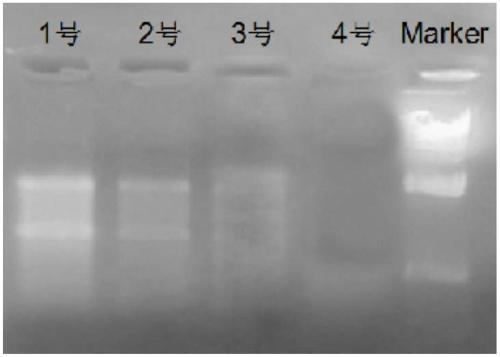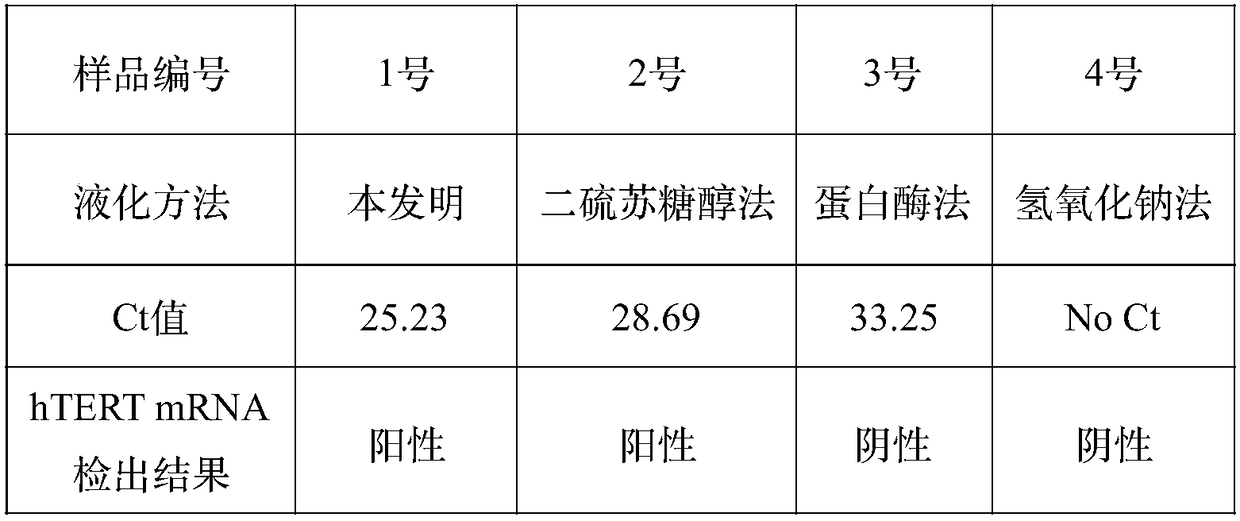Reagent for liquefying phlegm and protecting nucleic acid
A nucleic acid protection and reagent technology, applied in the direction of DNA preparation, recombinant DNA technology, etc., can solve the problems of time-consuming, high viscosity of sputum samples, incomplete mixing of samples, etc., and achieve the effect of simple production process and simple operation
- Summary
- Abstract
- Description
- Claims
- Application Information
AI Technical Summary
Problems solved by technology
Method used
Image
Examples
Embodiment 1
[0023] A reagent for liquefaction of sputum and nucleic acid protection. Weigh 2.5 g of guanidine hydrochloride + 0.5 g of cysteine + 2 g of polypropylene particles and mix evenly to prepare the reagent of this embodiment.
[0024] Comparative experiment on the effect of this reagent and the traditional method on the liquefaction of sputum
[0025] Step 1: Prepare 8-10 cases of visually viscous sputum samples collected from the hospital, mix these sputum samples thoroughly, and take 4 3ml samples respectively, numbered 1-4;
[0026] Step 2: Add the sputum liquefaction and nucleic acid protection reagent of the present embodiment to No. 1 sample; Add 6ml dithiothreitol solution (2%) to No. 2 sample; Add 6ml trypsin solution (2%) to No. 3 sample buffer system containing pH7.0); add 6ml of sodium hydroxide solution (0.1mol / L) to sample No. 4, shake and mix the above samples for 5 minutes;
[0027] Step 3: Use filter paper to filter the 4 liquefied samples obtained in the previou...
Embodiment 2
[0029] Example 2: Comparison of the protective effect of this reagent and traditional methods on sputum nucleic acid after liquefaction
[0030] Step 1: Prepare 4-6 sputum samples of lung cancer patients collected from the hospital, mix these sputum samples thoroughly, and take 4 2ml samples respectively, numbered 1-4;
[0031] Step 2: add the sputum liquefaction and nucleic acid protection reagent of embodiment 1 in No. 1 sample; Add 6ml dithiothreitol solution (2%) in No. 2 sample; Add 6ml trypsin solution (2%) in No. 3 sample buffer system containing pH7.0); add 6ml of sodium hydroxide solution (0.1mol / L) to sample No. 4, shake and mix the above samples for 5 minutes;
[0032] Step 3: Fluorescent quantitative PCR method to detect mRNA in the sample: use the "Telomerase Reverse Transcriptase Subunit (hTERT) mRNA Detection Kit" developed by Zhejiang Jinfukang Biotechnology Co., Ltd. - hTERT mRNA in sample no. 4. The test results are shown in the table below. Samples 1-2 are...
Embodiment 3
[0035] Example 3: Comparison of nucleic acid protection effects of different formulation combination reagents
[0036] Step 1: Prepare 15-20 sputum samples of lung cancer patients collected from the hospital, mix these sputum samples thoroughly, take 20 samples of 2ml respectively, and use 4 samples as a group to obtain 5 groups of samples in total;
[0037] Step 2: Configure the combined protective agent as shown in the table below:
[0038]
[0039]
[0040] Step 3: Add reagent 1-reagent 5 to the 5 groups of sputum samples respectively; place the sample tubes at 37°C for 36 hours, 72 hours, 120 hours, and 168 hours for testing;
[0041] Step 3: Use the Telomerase Reverse Transcriptase Subunit (hTERT) mRNA Detection Kit" (National Machinery Note 20173404247) to detect the samples obtained in step 3 according to the operation steps in the product manual. The experimental results are shown in the table below. The results show that , reagent 1-reagent 5 within the scope o...
PUM
 Login to View More
Login to View More Abstract
Description
Claims
Application Information
 Login to View More
Login to View More - R&D
- Intellectual Property
- Life Sciences
- Materials
- Tech Scout
- Unparalleled Data Quality
- Higher Quality Content
- 60% Fewer Hallucinations
Browse by: Latest US Patents, China's latest patents, Technical Efficacy Thesaurus, Application Domain, Technology Topic, Popular Technical Reports.
© 2025 PatSnap. All rights reserved.Legal|Privacy policy|Modern Slavery Act Transparency Statement|Sitemap|About US| Contact US: help@patsnap.com



